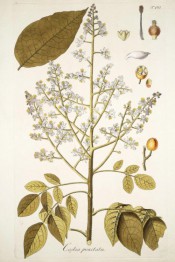Clausena lansium Skeels
Frost hardy, middle-sized tree with pinnate leaves composed of rounded lance-shaped leaflets, panicles of small white flowers followed by edible pigeon egg-sized fruit, with yellow skin and white, slightly acrid but sweet pulp. To 6m. [RHSD, Hortus].
Horticultural & Botanical History
First grown in Europe in 1795. Don reports that the fruit was sold in the markets of Canton. ‘A fruit highly esteemed in China and the Indian archipelago.’ ‘A Chinese fruit tree, now common in Bengal, and various other parts of India. Flowering time the beginning of the hot season; the fruit ripe in three or four months after. […] The fruit, and indeed every part of the tree, possess a peculiar kind of agreeable fragrance, which is something of a Terebinthinaceous nature.’ [Roxburgh FI p.382/1832]. The genus Cookia was named for Captain Cook. [Don]. Jacq. Sch. pl.101/1797-04.
History at Camden Park
Listed in the 1850 and 1857 catalogues [T.343/1850]. One of a number of plants received from Captain Simpson in late 1849 or early 1850, apparently on the same ship as those accompanying Captain P. P. King. The source is unclear. [ML A1980-3].
Notes
Cookia punctata Hassk. (1844) = Mocromelum pubescens Blume.
Cookia punctata Retz. (1779-91) = Clausena excavata Burm.f.
Published Feb 14, 2010 - 04:53 PM | Last updated Jul 31, 2010 - 03:04 PM
| Family | Rutaceae |
|---|---|
| Category | |
| Region of origin | China |
| Synonyms |
|
| Common Name | Dotted wampee tree |
| Name in the Camden Park Record |
Cookia punctata |
| Confidence level | high |
